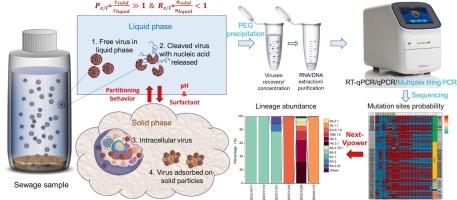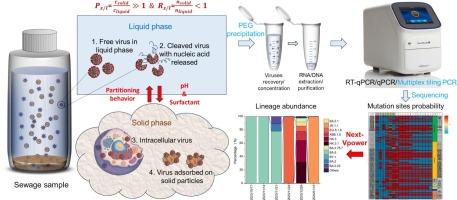加强对呼吸道病毒的废水监测:揭示分配行为和分离共循环谱系
IF 9.7
1区 环境科学与生态学
Q1 ENVIRONMENTAL SCIENCES
引用次数: 0
摘要
基于废水的流行病学(WBE)能够实现社区水平的病原体监测,但对病毒分配行为的不完整理解使策略优化和数据解释复杂化。我们证明了pH值和表面活性剂对废水相之间的病毒分布起关键作用。尽管固液分割系数很高,但由于废水的固含量较低(102-103 mg/L),病毒主要存在于液相。利用这些见解,我们在四川大学和成都进行了为期一年的RT-qPCR监测,捕获了两次SARS-CoV-2波和一次甲型流感爆发。为了解决来自次优测序的谱系分离挑战,我们开发了NextVpower,这是一种解决共循环谱系的反卷积工具,同时跟踪临床早期预警的关键突变。值得注意的是,NextVpower首次实现了废水中H3N2甲型流感病毒HA-和na -谱系的分离。这提高了WBE将废水产生的突变与流行病学趋势联系起来的能力,通过优化病毒恢复和谱系解析分析加强了实时暴发准备工作。本文章由计算机程序翻译,如有差异,请以英文原文为准。


Enhanced wastewater surveillance of respiratory viruses: Unraveling partitioning behavior and demixing co-circulating lineages
Wastewater-based epidemiology (WBE) enables community-level pathogen surveillance, yet incomplete understanding of viral partitioning behavior complicates strategy optimization and data interpretation. We demonstrated that pH and surfactants critically govern viral distribution between wastewater phases. Despite high solid–liquid partition coefficients, viruses predominantly reside in the liquid phase due to wastewater’s low solid content (102-103 mg/L). Leveraging these insights, we conducted one-year RT-qPCR surveillance across Sichuan University and Chengdu, capturing two SARS-CoV-2 waves and an influenza A outbreak. To address lineage demixing challenges from suboptimal sequencing, we developed NextVpower, a deconvolution tool resolving co-circulating lineages while tracking critical mutations for clinical early-warning. Notably, NextVpower achieved the first demixing of both HA- and NA-lineages for H3N2 influenza A virus in wastewater. This advances WBE’s capacity to link wastewater-derived mutations to epidemiological trends, enhancing real-time outbreak preparedness through optimized viral recovery and lineage-resolved analytics.
求助全文
通过发布文献求助,成功后即可免费获取论文全文。
去求助
来源期刊

Environment International
环境科学-环境科学
CiteScore
21.90
自引率
3.40%
发文量
734
审稿时长
2.8 months
期刊介绍:
Environmental Health publishes manuscripts focusing on critical aspects of environmental and occupational medicine, including studies in toxicology and epidemiology, to illuminate the human health implications of exposure to environmental hazards. The journal adopts an open-access model and practices open peer review.
It caters to scientists and practitioners across all environmental science domains, directly or indirectly impacting human health and well-being. With a commitment to enhancing the prevention of environmentally-related health risks, Environmental Health serves as a public health journal for the community and scientists engaged in matters of public health significance concerning the environment.
 求助内容:
求助内容: 应助结果提醒方式:
应助结果提醒方式:


